oil Hyundai Santa Fe 2014 Owner's Manual
[x] Cancel search | Manufacturer: HYUNDAI, Model Year: 2014, Model line: Santa Fe, Model: Hyundai Santa Fe 2014Pages: 711, PDF Size: 14.72 MB
Page 10 of 711
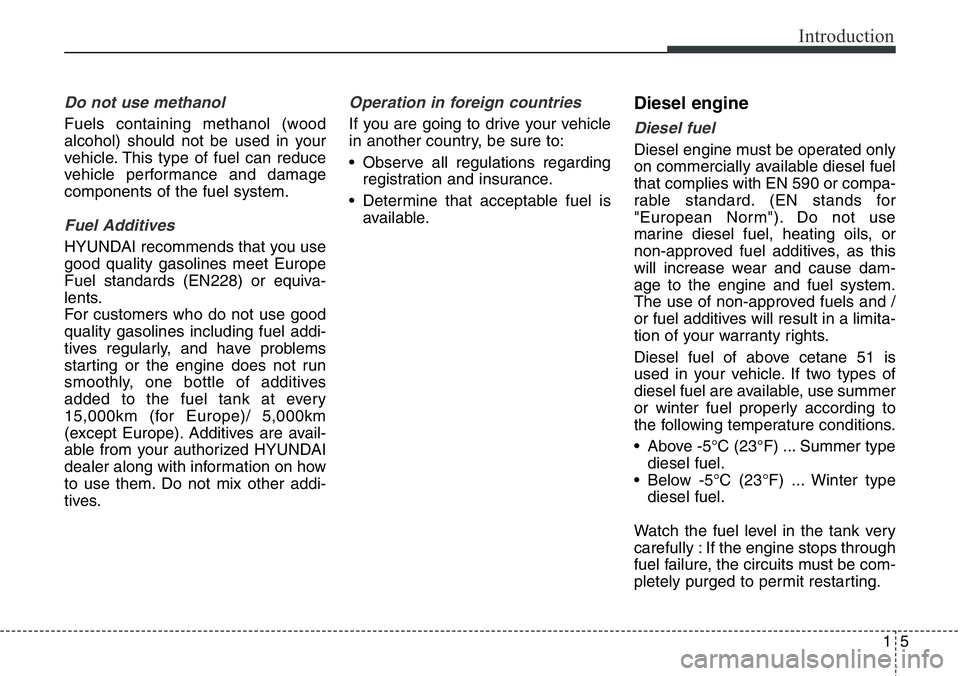
15
Introduction
Do not use methanol
Fuels containing methanol (wood
alcohol) should not be used in your
vehicle. This type of fuel can reduce
vehicle performance and damage
components of the fuel system.
Fuel Additives
HYUNDAI recommends that you use
good quality gasolines meet Europe
Fuel standards (EN228) or equiva-
lents.
For customers who do not use good
quality gasolines including fuel addi-
tives regularly, and have problems
starting or the engine does not run
smoothly, one bottle of additives
added to the fuel tank at every
15,000km (for Europe)/ 5,000km
(except Europe). Additives are avail-
able from your authorized HYUNDAI
dealer along with information on how
to use them. Do not mix other addi-
tives.
Operation in foreign countries
If you are going to drive your vehicle
in another country, be sure to:
• Observe all regulations regarding
registration and insurance.
• Determine that acceptable fuel is
available.
Diesel engine
Diesel fuel
Diesel engine must be operated only
on commercially available diesel fuel
that complies with EN 590 or compa-
rable standard. (EN stands for
"European Norm"). Do not use
marine diesel fuel, heating oils, or
non-approved fuel additives, as this
will increase wear and cause dam-
age to the engine and fuel system.
The use of non-approved fuels and /
or fuel additives will result in a limita-
tion of your warranty rights.
Diesel fuel of above cetane 51 is
used in your vehicle. If two types of
diesel fuel are available, use summer
or winter fuel properly according to
the following temperature conditions.
• Above -5°C (23°F) ... Summer type
diesel fuel.
• Below -5°C (23°F) ... Winter type
diesel fuel.
Watch the fuel level in the tank very
carefully : If the engine stops through
fuel failure, the circuits must be com-
pletely purged to permit restarting.
Page 11 of 711
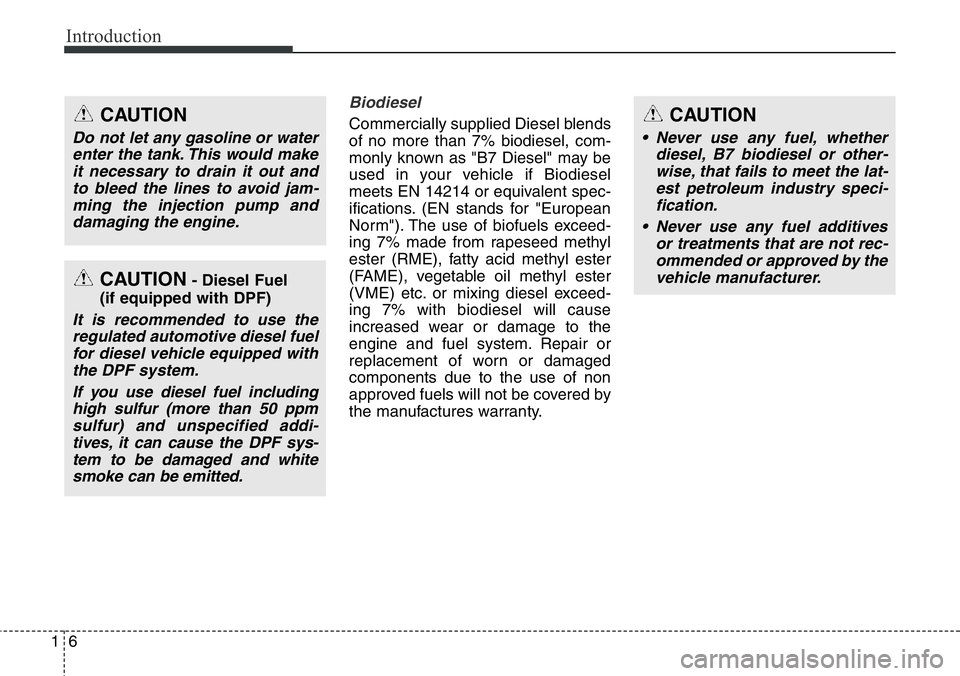
Introduction
6 1
Biodiesel
Commercially supplied Diesel blends
of no more than 7% biodiesel, com-
monly known as "B7 Diesel" may be
used in your vehicle if Biodiesel
meets EN 14214 or equivalent spec-
ifications. (EN stands for "European
Norm"). The use of biofuels exceed-
ing 7% made from rapeseed methyl
ester (RME), fatty acid methyl ester
(FAME), vegetable oil methyl ester
(VME) etc. or mixing diesel exceed-
ing 7% with biodiesel will cause
increased wear or damage to the
engine and fuel system. Repair or
replacement of worn or damaged
components due to the use of non
approved fuels will not be covered by
the manufactures warranty.CAUTION
Do not let any gasoline or water
enter the tank. This would make
it necessary to drain it out and
to bleed the lines to avoid jam-
ming the injection pump and
damaging the engine.
CAUTION- Diesel Fuel
(if equipped with DPF)
It is recommended to use the
regulated automotive diesel fuel
for diesel vehicle equipped with
the DPF system.
If you use diesel fuel including
high sulfur (more than 50 ppm
sulfur) and unspecified addi-
tives, it can cause the DPF sys-
tem to be damaged and white
smoke can be emitted.
CAUTION
• Never use any fuel, whether
diesel, B7 biodiesel or other-
wise, that fails to meet the lat-
est petroleum industry speci-
fication.
• Never use any fuel additives
or treatments that are not rec-
ommended or approved by the
vehicle manufacturer.
Page 22 of 711
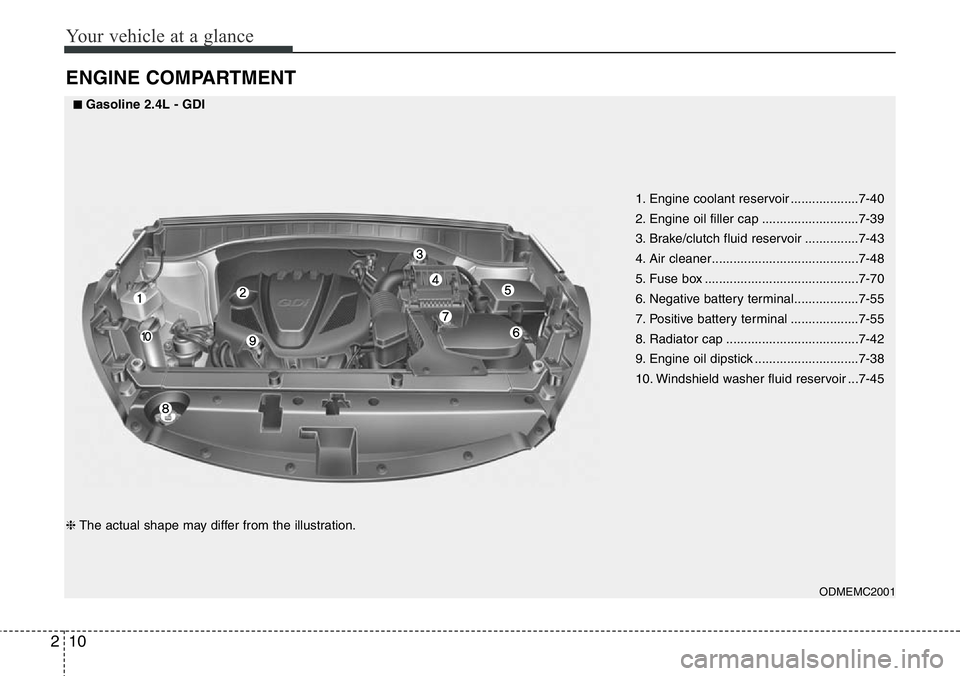
Your vehicle at a glance
10 2
ENGINE COMPARTMENT
1. Engine coolant reservoir ...................7-40
2. Engine oil filler cap ...........................7-39
3. Brake/clutch fluid reservoir ...............7-43
4. Air cleaner.........................................7-48
5. Fuse box ...........................................7-70
6. Negative battery terminal..................7-55
7. Positive battery terminal ...................7-55
8. Radiator cap .....................................7-42
9. Engine oil dipstick .............................7-38
10. Windshield washer fluid reservoir ...7-45
ODMEMC2001
■Gasoline 2.4L - GDI
❈The actual shape may differ from the illustration.
Page 23 of 711
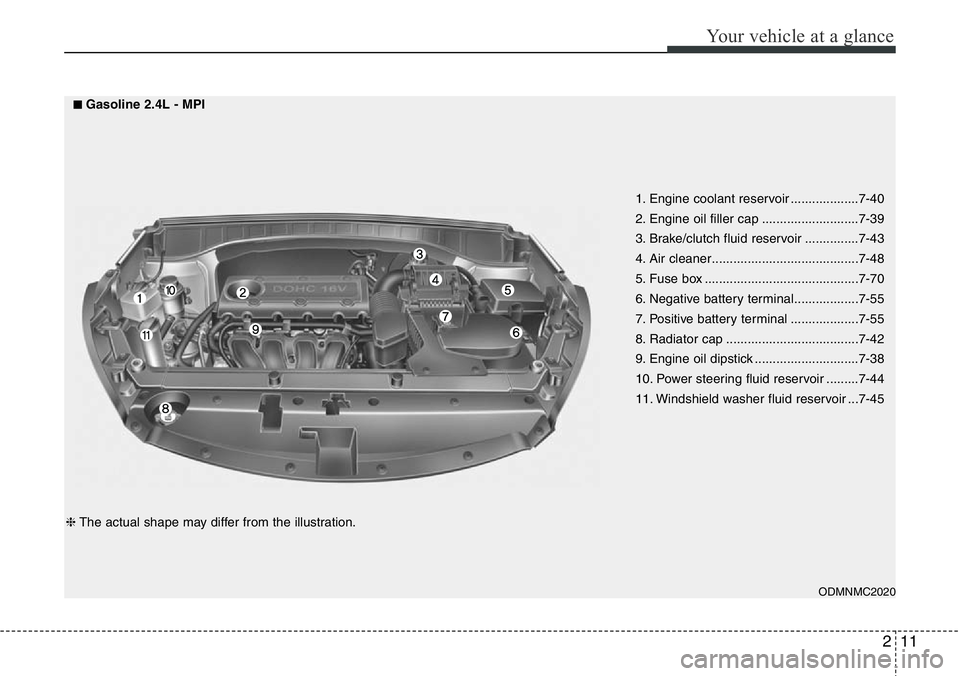
211
Your vehicle at a glance
1. Engine coolant reservoir ...................7-40
2. Engine oil filler cap ...........................7-39
3. Brake/clutch fluid reservoir ...............7-43
4. Air cleaner.........................................7-48
5. Fuse box ...........................................7-70
6. Negative battery terminal..................7-55
7. Positive battery terminal ...................7-55
8. Radiator cap .....................................7-42
9. Engine oil dipstick .............................7-38
10. Power steering fluid reservoir .........7-44
11. Windshield washer fluid reservoir ...7-45
ODMNMC2020
■Gasoline 2.4L - MPI
❈The actual shape may differ from the illustration.
Page 24 of 711
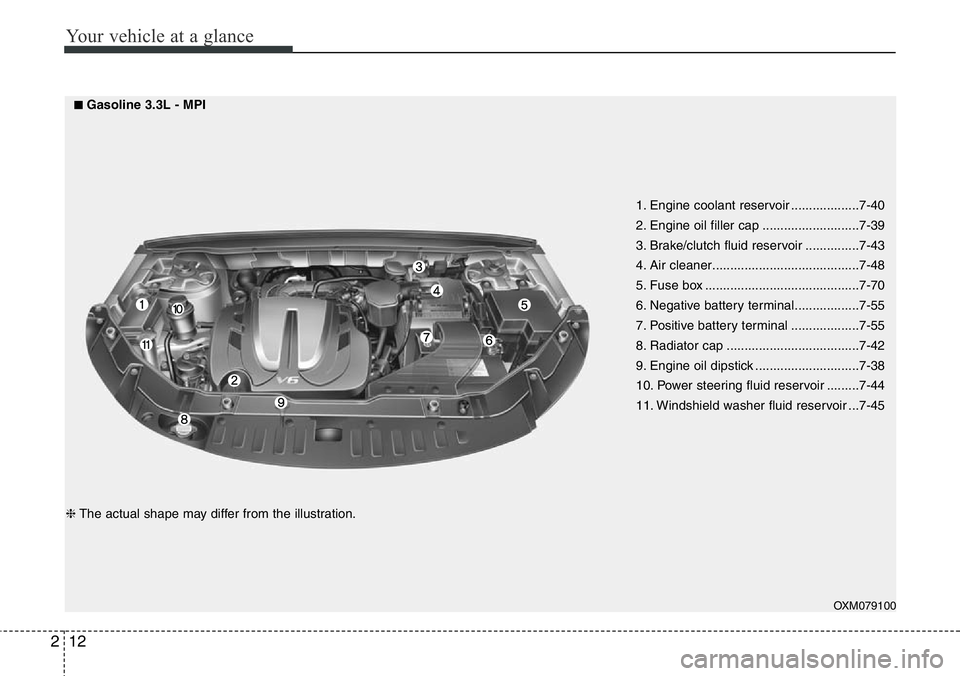
Your vehicle at a glance
12 2
OXM079100
1. Engine coolant reservoir ...................7-40
2. Engine oil filler cap ...........................7-39
3. Brake/clutch fluid reservoir ...............7-43
4. Air cleaner.........................................7-48
5. Fuse box ...........................................7-70
6. Negative battery terminal..................7-55
7. Positive battery terminal ...................7-55
8. Radiator cap .....................................7-42
9. Engine oil dipstick .............................7-38
10. Power steering fluid reservoir .........7-44
11. Windshield washer fluid reservoir ...7-45
■Gasoline 3.3L - MPI
❈The actual shape may differ from the illustration.
Page 25 of 711
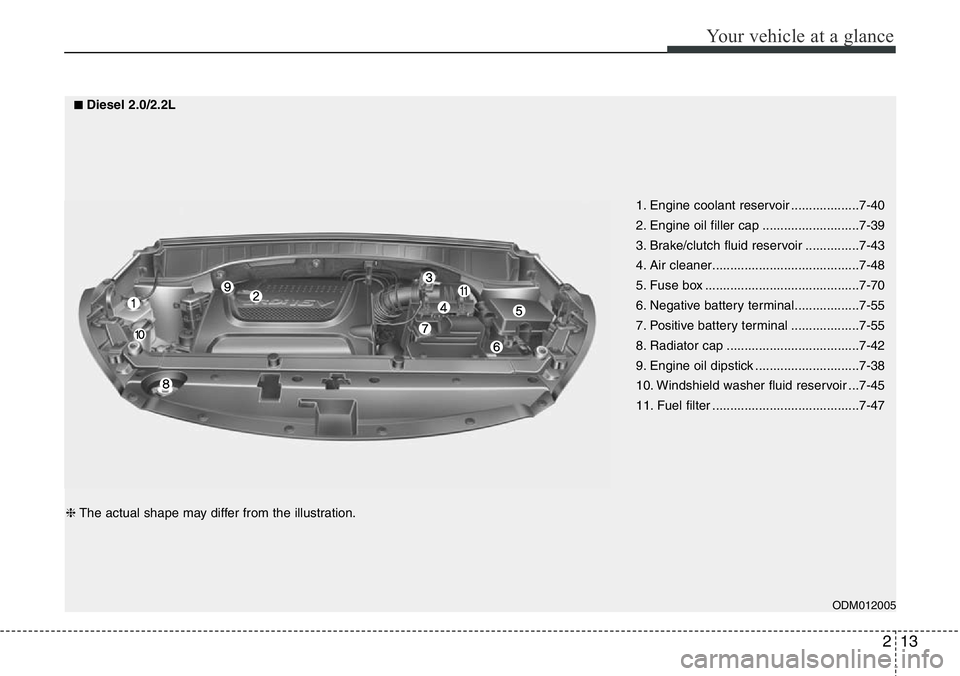
213
Your vehicle at a glance
ODM012005
1. Engine coolant reservoir ...................7-40
2. Engine oil filler cap ...........................7-39
3. Brake/clutch fluid reservoir ...............7-43
4. Air cleaner.........................................7-48
5. Fuse box ...........................................7-70
6. Negative battery terminal..................7-55
7. Positive battery terminal ...................7-55
8. Radiator cap .....................................7-42
9. Engine oil dipstick .............................7-38
10. Windshield washer fluid reservoir ...7-45
11. Fuel filter .........................................7-47
■Diesel 2.0/2.2L
❈The actual shape may differ from the illustration.
Page 51 of 711
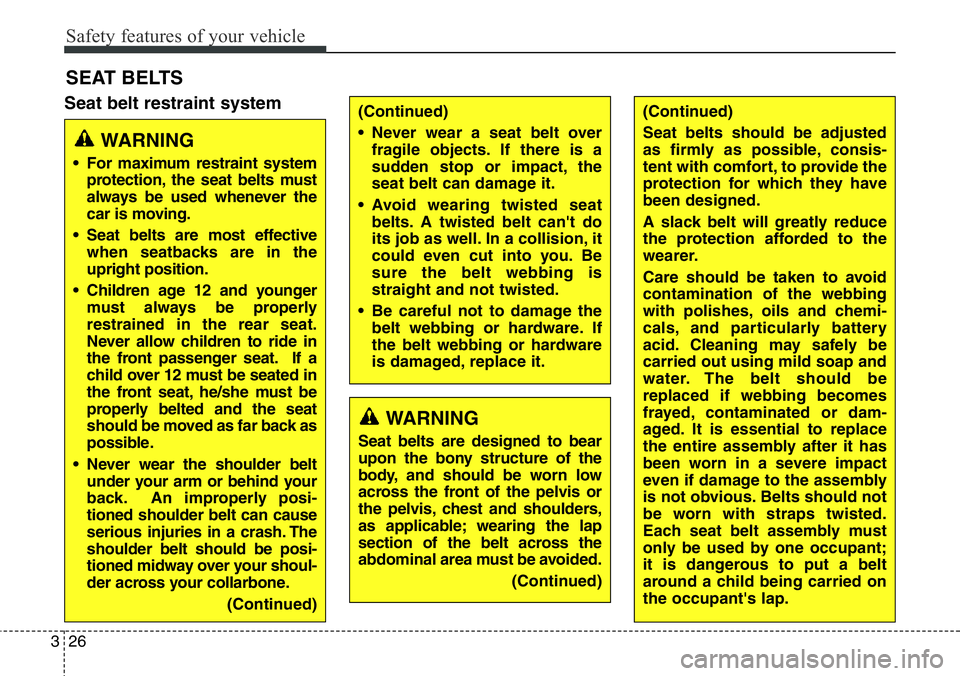
Safety features of your vehicle
26 3
Seat belt restraint system
SEAT BELTS
(Continued)
• Never wear a seat belt over
fragile objects. If there is a
sudden stop or impact, the
seat belt can damage it.
• Avoid wearing twisted seat
belts. A twisted belt can't do
its job as well. In a collision, it
could even cut into you. Be
sure the belt webbing is
straight and not twisted.
• Be careful not to damage the
belt webbing or hardware. If
the belt webbing or hardware
is damaged, replace it.
WARNING
Seat belts are designed to bear
upon the bony structure of the
body, and should be worn low
across the front of the pelvis or
the pelvis, chest and shoulders,
as applicable; wearing the lap
section of the belt across the
abdominal area must be avoided.
(Continued)
WARNING
• For maximum restraint system
protection, the seat belts must
always be used whenever the
car is moving.
• Seat belts are most effective
when seatbacks are in the
upright position.
• Children age 12 and younger
must always be properly
restrained in the rear seat.
Never allow children to ride in
the front passenger seat. If a
child over 12 must be seated in
the front seat, he/she must be
properly belted and the seat
should be moved as far back as
possible.
• Never wear the shoulder belt
under your arm or behind your
back. An improperly posi-
tioned shoulder belt can cause
serious injuries in a crash. The
shoulder belt should be posi-
tioned midway over your shoul-
der across your collarbone.
(Continued)
(Continued)
Seat belts should be adjusted
as firmly as possible, consis-
tent with comfort, to provide the
protection for which they have
been designed.
A slack belt will greatly reduce
the protection afforded to the
wearer.
Care should be taken to avoid
contamination of the webbing
with polishes, oils and chemi-
cals, and particularly battery
acid. Cleaning may safely be
carried out using mild soap and
water. The belt should be
replaced if webbing becomes
frayed, contaminated or dam-
aged. It is essential to replace
the entire assembly after it has
been worn in a severe impact
even if damage to the assembly
is not obvious. Belts should not
be worn with straps twisted.
Each seat belt assembly must
only be used by one occupant;
it is dangerous to put a belt
around a child being carried on
the occupant's lap.
Page 190 of 711
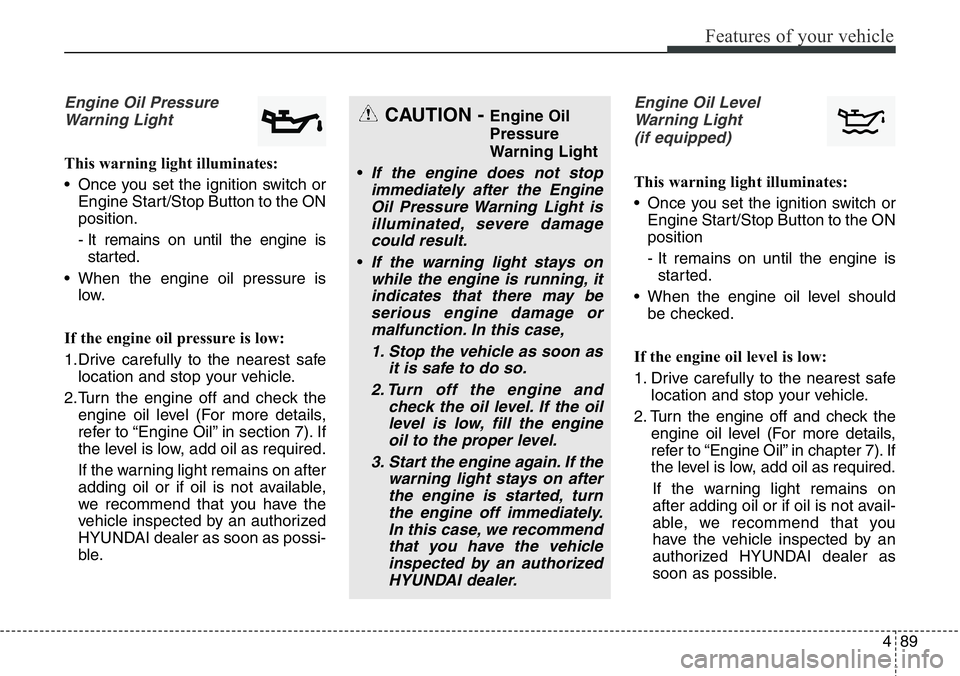
489
Features of your vehicle
Engine Oil Pressure
Warning Light
This warning light illuminates:
• Once you set the ignition switch or
Engine Start/Stop Button to the ON
position.
- It remains on until the engine is
started.
• When the engine oil pressure is
low.
If the engine oil pressure is low:
1.Drive carefully to the nearest safe
location and stop your vehicle.
2.Turn the engine off and check the
engine oil level (For more details,
refer to “Engine Oil” in section 7). If
the level is low, add oil as required.
If the warning light remains on after
adding oil or if oil is not available,
we recommend that you have the
vehicle inspected by an authorized
HYUNDAI dealer as soon as possi-
ble.
Engine Oil Level
Warning Light
(if equipped)
This warning light illuminates:
• Once you set the ignition switch or
Engine Start/Stop Button to the ON
position
- It remains on until the engine is
started.
• When the engine oil level should
be checked.
If the engine oil level is low:
1. Drive carefully to the nearest safe
location and stop your vehicle.
2. Turn the engine off and check the
engine oil level (For more details,
refer to “Engine Oil” in chapter 7). If
the level is low, add oil as required.
If the warning light remains on
after adding oil or if oil is not avail-
able, we recommend that you
have the vehicle inspected by an
authorized HYUNDAI dealer as
soon as possible.
CAUTION - Engine Oil
Pressure
Warning Light
•
If the engine does not stop
immediately after the Engine
Oil Pressure Warning Light is
illuminated, severe damage
could result.
•If the warning light stays on
while the engine is running, it
indicates that there may be
serious engine damage or
malfunction. In this case,
1. Stop the vehicle as soon as
it is safe to do so.
2. Turn off the engine and
check the oil level. If the oil
level is low, fill the engine
oil to the proper level.
3. Start the engine again. If the
warning light stays on after
the engine is started, turn
the engine off immediately.
In this case, we recommend
that you have the vehicle
inspected by an authorized
HYUNDAI dealer.
Page 252 of 711
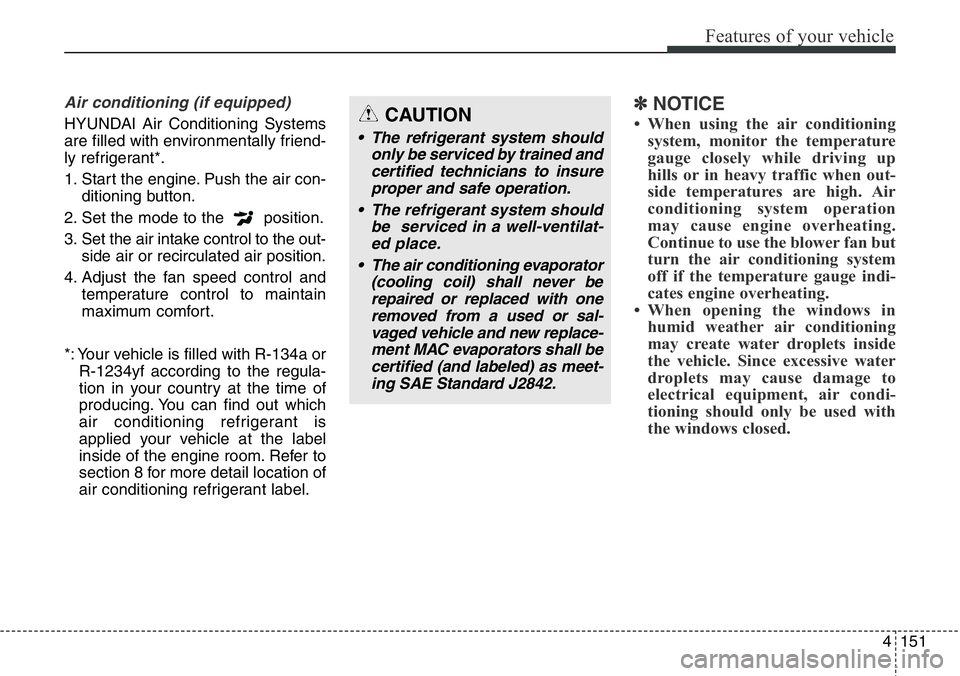
4151
Features of your vehicle
Air conditioning (if equipped)
HYUNDAI Air Conditioning Systems
are filled with environmentally friend-
ly refrigerant*.
1. Start the engine. Push the air con-
ditioning button.
2. Set the mode to the position.
3. Set the air intake control to the out-
side air or recirculated air position.
4. Adjust the fan speed control and
temperature control to maintain
maximum comfort.
*: Your vehicle is filled with R-134a or
R-1234yf according to the regula-
tion in your country at the time of
producing. You can find out which
air conditioning refrigerant is
applied your vehicle at the label
inside of the engine room. Refer to
section 8 for more detail location of
air conditioning refrigerant label.
✽NOTICE
• When using the air conditioning
system, monitor the temperature
gauge closely while driving up
hills or in heavy traffic when out-
side temperatures are high. Air
conditioning system operation
may cause engine overheating.
Continue to use the blower fan but
turn the air conditioning system
off if the temperature gauge indi-
cates engine overheating.
• When opening the windows in
humid weather air conditioning
may create water droplets inside
the vehicle. Since excessive water
droplets may cause damage to
electrical equipment, air condi-
tioning should only be used with
the windows closed.CAUTION
• The refrigerant system should
only be serviced by trained and
certified technicians to insure
proper and safe operation.
• The refrigerant system should
be serviced in a well-ventilat-
ed place.
• The air conditioning evaporator
(cooling coil) shall never be
repaired or replaced with one
removed from a used or sal-
vaged vehicle and new replace-
ment MAC evaporators shall be
certified (and labeled) as meet-
ing SAE Standard J2842.
Page 255 of 711
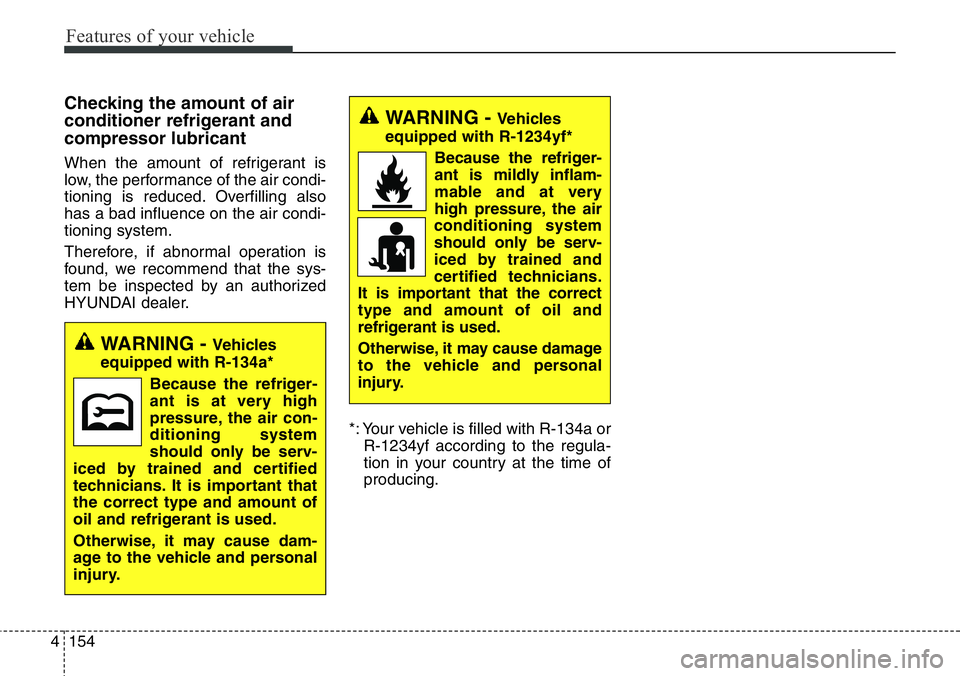
Features of your vehicle
154 4
Checking the amount of air
conditioner refrigerant and
compressor lubricant
When the amount of refrigerant is
low, the performance of the air condi-
tioning is reduced. Overfilling also
has a bad influence on the air condi-
tioning system.
Therefore, if abnormal operation is
found, we recommend that the sys-
tem be inspected by an authorized
HYUNDAI dealer.
*: Your vehicle is filled with R-134a or
R-1234yf according to the regula-
tion in your country at the time of
producing.
WARNING - Vehicles
equipped with R-1234yf*
Because the refriger-
ant is mildly inflam-
mable and at very
high pressure, the air
conditioning system
should only be serv-
iced by trained and
certified technicians.
It is important that the correct
type and amount of oil and
refrigerant is used.
Otherwise, it may cause damage
to the vehicle and personal
injury.
WARNING - Vehicles
equipped with R-134a*
Because the refriger-
ant is at very high
pressure, the air con-
ditioning system
should only be serv-
iced by trained and certified
technicians. It is important that
the correct type and amount of
oil and refrigerant is used.
Otherwise, it may cause dam-
age to the vehicle and personal
injury.